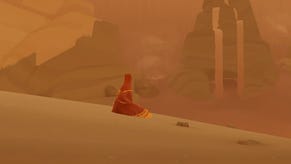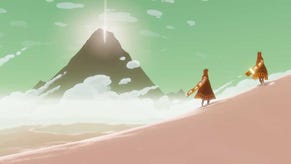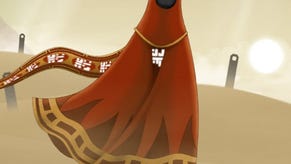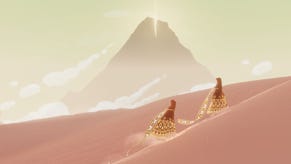Adventure Time: Thatgamecompany on Journey
The desert is vast, but you're not alone on your Journey. Production lead Robin Hunicke takes Nathan Grayson by the hand and leads him into the sands.
One of the things that first really got me into games is their ability to inspire this sense of pure, slack-jawed wonderment. I still vividly remember taking my first steps into Ocarina of Time's then-massive world (after that freakish stalker terror owl decided to finally go right back to hell) and making unearthly child squeals at the prospect of infinite adventure. To my still-solidifying blob of a child brain, this was a playground without limits. I could go where I wanted, when I wanted. I was both all-powerful and utterly insignificant – completely at the mercy of all the mysterious forces lurking in Hyrule's unruly wilds.
So it's a bit strange that I decided to become a games writer. I mean, what's the fastest way to obliterate any sense of mystique or majesty? Why, take a look behind the curtain, of course. Suddenly, that movie star's not so glamorous, that rock 'n' roll demigod's a coke fiend, and that videogame is a bunch of cold, unfeeling zeroes and ones. So long, wonderment. Hello, jaded judgement and measured cynicism.
That, I think, is why I find myself so inescapably attracted to Journey. I've played it at multiple events. I've shared drinks with its creators. I know that – in reality – it's not some magical fairy world that's been gently crammed onto a hard drive. People created it. It has limits. And yet, that actually makes it all the more interesting to me. This is a game world that's very much taken on a life of its own, and – unlike many heavy handed developers who snatch the wheel away at every turn – thatgamecompany is embracing its lack of control.
“How would you do this if you were writing?” began executive producer Robin Hunicke.
“You start with a character and narration that's spelled out. Then you write a little bit of the beginning and an outline of what the character's going to go through. Then you spend a lot of time just sketching out the piece. What would the character do in this situation? What if this happened to the character? What if this happened to the character? Until you really know your character.
“And then you look at the sketches you did for the arc at the beginning, and you're like 'This is crap!' And you throw it all away. But then you know your character, and you write the real story. The character helps you write it. Once you know each other, it's a collaborative process between you and the character.
"Sometimes good things take a little bit longer."
“When a good indie game comes out, and you play through it and you're really moved, I guarantee that's what happens,” she explained.
“Whether it's a mechanic or a storyline or something else really, really important, someone who was working on that took the time to understand it. To get to know that mechanic or character very deeply. And then they were able to create what you play.
"That's why sometimes good things take a little bit longer. Really good novels – I'm sure there are some people who just rip 'em out. But sometimes, it takes a little while to get to know your idea.”
Less action, more adventure
I began my Journey demo by ascending a hill. Slowly. Very, very slowly. My tiny red-cloaked character trudged through sand with all the urgency of a sloth doing, well, anything. In most games, that'd pretty much be a nail in pacing's coffin, but in Journey, that's the point.
“I'm not sure if what people really want is to be told all the time what to do – or not be told what to do – so much as that sometimes people need a break,” said Hunicke. “Sometimes you just want to sit with a friend and have a cup of coffee, right? It would be nice if some videogames were like that. Let's go someplace quiet and have a walk. One of our core inspirations was a trip to the Pismo dunes outside Los Angeles where – as a whole team – we had a retreat.”
“We spent two days just walking in the sand, sitting out in the heat, understanding what it feels like to walk in bare sand with bare feet. To slide down dunes and get sand in your pants, you know? Feel the texture of the sand as it brushes your fingers and your face. See the sand in the wind. Hear the way that sounds change when you're among a series of dunes versus on top.”
“Those moments are the things you don't get when you're running to your job and getting on the train and trying to make a meeting. If we could create an environment where you felt that sense of smallness or nature or... it's hard to put a word on it. But that'd be a pretty awesome experiment, so that's what we went for.”
Big talk. Huge talk. Honestly, if I hadn't seen it delivered with such conviction, I'd probably toss my head back and laugh at the sheer hyperbole of it. But Hunicke's sincerity was utterly infectious. This is a project she absolutely believes in, and that conviction was written all over her face. The gaming industry's obsession with marketing-speak bullshit drives me insane precisely because it drowns out the folks who actually love making games. People like the ones working at thatgamecompany. But then, words only go so far, and it was the game proper that ultimately convinced me.
As I played, my mind wandered nearly as much as my character. And why not? After all, I wasn't getting an earful from some military mouthpiece every 30 seconds or punching explosions at everything that moved. Honestly, there wasn't really much movement to begin with. The sea of graves that greeted me at the game's outset made it clear that the desert's denizens had settled down and taken up a new hobby: you know, dying. But why? How? When? Journey didn't spell out any of those details for me, so my brain naturally poked and prodded at that puzzle.
All the while, I closely observed everything from the largest, most majestic sand mountain to the smallest piece of frayed fabric billowing in the breeze. I paid attention, is what I'm saying. By taking away the constant stimulation that so characterizes modern games and even the ability to jump without using up precious, er, scarf magic, Journey made it extremely compelling for me to explore for exploration's sake. Sometimes, less is more. That's the mantra that makes Journey tick, and – though the game takes place in some ethereal, far-away land – it actually hits quite close to home.
By taking away the constant stimulation that so characterizes modern games Journey made it extremely compelling for me to explore for exploration's sake. Sometimes, less is more.
“We live in a world where you can do so much stuff,” said Hunicke.
“Like, right now, if you just picked up this iPhone, we could look up any single thing in the universe on it, really. It's like having the library of Alexandria right there in your hands.
"A big inspiration for Journey is the fact that we're so powerful that it's hard for us to sometimes not be executing our power all the time.
“I'm sure you've had that conversation at a dinner party where someone's like 'Wait, I know this!' And immediately, the phone comes out, and they're looking it up on Wikipedia.
"It takes effort to be present in a world where you can constantly exercise your power and change the present to be something more like what you want.”
Go with the flow
That's not to say the game is utterly bereft of traditional game mechanics, but Journey focuses on, well, the journey. As a result, movement – whether it's sliding down sand dunes, galloping across bridges, or flying for brief, incredibly satisfying moments – is one of the game's biggest priorities.
“This idea of deep movement – experiencing the environment in a tactile way – [was very important to us],” Hunicke was quick to say.
“Our lead engineer spent a lot of time after we got back from Pismo thinking about sand, rendering the sand, figuring out how to make it fluid, and also how to make the animation fluid with the sand. But they're all new systems for us, so it was an opportunity to really design the game and its underlying technologies to support this feeling that the Journey was about movement as much as it was about the destination.”
Journey also places a very strong emphasis on co-op, but again, gleefully throws sand in the eyes of tradition. See, you can't communicate with your co-op partner. At all. No voice chat, no typing. Hell, you can't even look them up after exiting your session. Instead, you simply encounter other players wandering. Maybe you lend them a hand, or maybe you opt to go your own way (which is a Fleetwood Mac reference; that is the absolute closest thing you will get to a reference to, you know, that band in this article).
Honestly, it's a bit terrifying. After all, you've been on an Internet forum before. You know how this works. Internet anonymity can be a terrible, terrible thing. In Journey, though, it's all about context.
“The experience of being inside the world of Journey is very different than being on a forum or arguing whether Nintendo is better than Microsoft or Microsoft is better than Sony,” said Hunicke.
"Our goal with the experience of playing Journey has always been to make it an environment where reaching out to another person feels natural. It doesn't feel like you have to do it. It's a choice."
“Our goal with the experience of playing Journey has always been to make it an environment where reaching out to another person feels natural. It doesn't feel like you have to do it. It's a choice. The game is a lot about what you bring to it. You know, life is that way. So I think it's up to you as a player.”
Thanks to the game's minimalistic mechanics, it's also quite difficult to troll other players. You can't steal magical, flight-enhancing scarf extensions, either. The game makes sure there are plenty to go around. Even so, I couldn't resist showboating when I encountered another player whose stylish neckwear best resembled a gym sock turned tiny, ineffective noose. So I took off soaring above my otherwise identical companion, occasionally drifting down to benefit from the seemingly infinite refill of magical energy that occurs when two players touch. “What an asshole,” my partner probably grumbled as he or she walked up another hill like some kind of land peasant.
Journey isn't all searing sunshine and ostensibly deceased butterflies, though. Again, this is – at its core – a game, and there's an aspect of challenge to overcome. Hunicke, however, was tight-lipped about what exactly it entails.
“It wouldn't be a real journey unless you had to struggle a little. And not every journey is the same and not every journey is easy. It definitely develops as time passes and you move closer to the mountain. And that's all we're going to say.”
Can't stop the journey
Journey, then, is a bit of an odd mix. In some areas, it seems like a total shot in the dark, and in others, it seems like thatgamecompany knows precisely – almost incredibly so – what it's doing. And in others still, there's nearly an aspect of naivety to it. Despite the fact that it's working with Sony, it almost seems as though thatgamecompany hasn't been exposed to the harsh realities of modern game development – or even life, in some cases. That's probably not at all the reality of the situation, but that's certainly how it seems. I don't think for a second, though, that it's a bad thing. There's no cynicism or jadedness here. Only hope and refreshing optimism.
“I say this all the time: We really weren't sure if it was going to work out,” admitted Hunicke. “What's fundamental to our philosophy of our development is that we should make an experimental game, put it out there, and let the public decide if it will be successful.
“The [main piece of] beta feedback, really, was just that people felt that they wanted it to keep going. We got a lot of email from people saying they were sad when they go to the end of the demo. They looked at the tower, and they wanted to get up there.
"A friend of mine wrote in and said – at the base of the tower, looking up – 'Let me in! Let me in!' So that was great, because it meant that people really wanted to keep journeying. We weren't wearing them out. It really can be fun to walk through the desert.”
And that, I suppose, is why Journey's able to inspire such wonderment in me. It's a game that I almost can't believe exists. Its creators are so passionate, and the game itself feels so sincere. My cynical side is screaming that something like this should be contrived. And maybe, on paper, it even sounds contrived.
But somehow, it works. But why? How? Well, Journey may not be in the business of easy answers, but I think I've got an explanation for this one. I'll let Hunicke do the talking:
“You have to ask yourself what you really want and what you really want to make. Why are you here? Life is short. It's too short to spend time working on something you're not passionate about, working on something with people who drive you crazy – you know, not doing what you want to do. You've got to be living your dreams. I mean, that's why we're here. It makes the world a better place. People doing things that make them really, really happy.”
Yeah.
Journey is a PlayStation Network exclusive expected in early 2012 after a recent delay.










